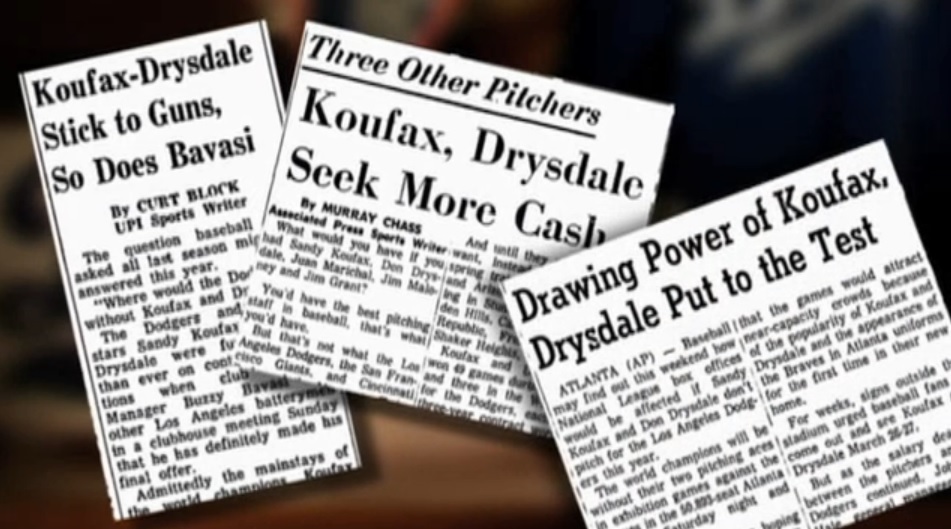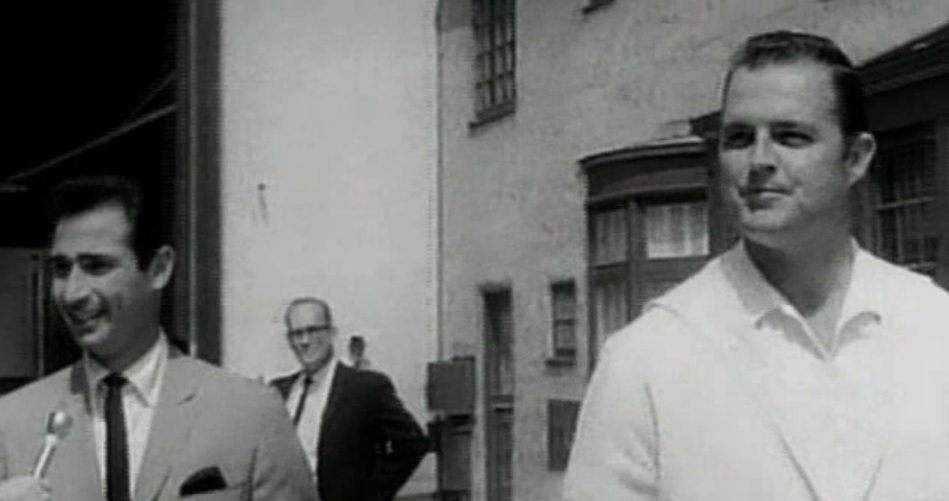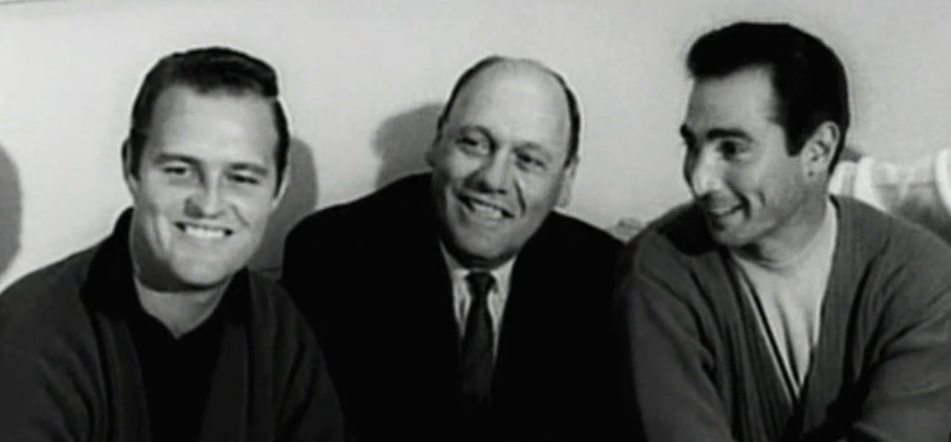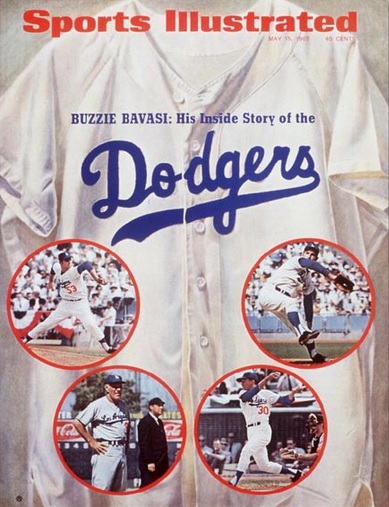Here is a fascinating time capsule from the Sandy Koufax-Don Drysdale era of the Dodgers from the front office perspective.
Buzzie Bavasi, general manager of the Dodgers for the bulk of the 1950s and 1960s, wrote a lengthy, first-person article in 1967 for Sports Illustrated describing the events before, during and after the Koufax-Drysdale holdout of the previous year. Be sure to click to read the entire story.
Bavasi makes no bones about his efforts to clear or correct the record, including what Koufax himself wrote (or had ghost-written). “I’m not saying that the chapter (on the holdout) is untrue,” Bavasi states. “I’m just saying that my memories of the double holdout and Sandy’s memories are two different things.”
Such disclaimers aside, Bavasi’s piece provides a window in the world of mid-1960s baseball operations and salary structures, as well as the disbelief that players could ever exert more power.
To tell the truth, I wasn’t too successful in the famous Koufax-Drysdale double holdout in 1966. I mean, when the smoke had cleared they stood together on the battlefield with $235,000 between them, and I stood there With a blood-stained cashbox. Well, they had a gimmick and it worked; I’m not denying it. They said that one wouldn’t sign unless the other signed. Since one of the two was the greatest pitcher I’ve ever seen (and possibly the greatest anybody has ever seen), the gimmick worked. But be sure to stick around for the fun the next time somebody tries that gimmick. I don’t care if the whole infield comes in as a package; the next year the whole infield will be wondering what it is doing playing for the Nankai Hawks.
 And let’s just say that Bavasi wasn’t completely moved by Koufax’s physical struggles, or at least felt more perspective was in order.
And let’s just say that Bavasi wasn’t completely moved by Koufax’s physical struggles, or at least felt more perspective was in order.
But Sandy did not suffer agonizing pain while he was pitching, and he never said he did, either. I think Roberto Clemente was on the right track when he said: “All I know about Sandy’s arthritis is that it must come after the game is over. Nobody could pitch the way Koufax does with something bothering him.” Sandy had arthritis, bad arthritis, no doubt about it, but if he had the pain that the press kept yelping about he’d have had to walk right off the mound. I never heard Sandy complain once about pain during a game. Of course, he’s that kind of guy; he wouldn’t say anything even if he was hurting. Simple common sense has to tell you that no one can chalk up the records he did with a sore arm. But how the papers worked on that painful legend! They used to show pictures of him pitching and his face would be all contorted, and the caption would say something about the agony the brave Koufax was going through. Why, I can show you similar pictures of every pitcher in baseball, including one of Sal Maglie where his face looks like there must be a scorpion in his undershorts, and all he’s doing is pitching to the No. 6 batter with two outs in the second inning and a 5-0 lead.
I know what made Sandy Koufax quit, and I agree with him 100%; in fact, as much as I hated to lose Sandy, I never suggested for a second that his reasoning was anything but correct. And here’s what his reasoning was: Sandy is a doer; he likes to play golf, to wire up fancy stereo sets, to fool with his cars and to go out and play and have fun, and every time he wound up and threw a baseball he ran the risk that some time in the future, some day maybe 10 years off, he would lose the use of that bad arm and not be capable of doing the things that he wanted to. In other words, he could stay in baseball and earn more and more money for his retirement years, but at the same time he might be destroying his retirement, because who the hell wants to go into a disabled retirement? Sandy was thinking ahead, that’s all. I’ll never forget what he told me: “Buzzie, I’m working hard, I’m not married, I’m saving a lot of money. I’ve stayed in baseball so that later on I’ll be able to do all the things I like to do. But suppose later on I’m physically unable to do those things? If I can’t do those things, why bother to work to make money for my retirement?”
 You need to read the entire story to get the full understanding of how the Dodgers at once depended on their top two pitchers while being, it seems fair to say, resentful of their demands. It’s clear that the negotiations with Koufax and Drysdale scarred Bavasi, but he sums his feelings after it was all over with this story of Koufax calling him on Thanksgiving.
You need to read the entire story to get the full understanding of how the Dodgers at once depended on their top two pitchers while being, it seems fair to say, resentful of their demands. It’s clear that the negotiations with Koufax and Drysdale scarred Bavasi, but he sums his feelings after it was all over with this story of Koufax calling him on Thanksgiving.
“What’s the big idea, interrupting my Thanksgiving dinner?” I said as gruffly as I could.
Sandy said, “I just called to wish you and Evit and all the family a happy Thanksgiving.”
“Well,” I said, “The same to you, Sandy.” I didn’t say a whole lot else. But I was as glad as if I had heard from the President.
Below, a 2012 MLB Network segment on the holdout.
[mlbvideo id=”20117895″ width=”550″ height=”308″ /]






Charles Moehringer
I hate to comment negaively on a man’s position after he’s gone but Buzzie Bavasi’s statement about “the one important reason that he drew more people was the fact that we tried to use him whenever we could in crucial games” is absolute garbage. Sandy started every four days, period. It didn’t matter who was the opposition or who was pitching for the other team. Go check the box score records. Also, no where in Bavasi’s remarks is any mention of Dodger finances and capability of paying Koufax and Drysdale what they asked for. I guess that stuff was considered confidential and not open for public scrutiny. So, you’re left with a one sided argument about the Dodger “budget” and how Bavasi was able to stay within budget. How real was that budget – I guess we”ll never know. As a Dodger fan in 1966 I blamed Dodger management’s stubbiness for Drysdale’s poor performance in the beginning of 1966 which may have due to the lack of a proper spring training.
leekfink
Really it’s hard for any of the baseball management claims about team’s finances to wash, knowing how the economics of the game changed just 10 years later with free agency, and the teams were better off than ever) (and today, they’ve never had it so good.
But it’s really interesting to see just how much Bavasi was living in the past, and how much management was able to get away with so long–no dealing with agents; no multi-year deals; no “double-holdouts” (i.e. collective bargaining), and stinginess in salaries.
Charles Moehringer
I remember reading somewhere (I think it was Drysdale’ book) that Drysdale’s and Koufax’s lawyer ‘agent’ was going to sue to have their reserve clauses revoked on the basis of the California law which was inacted because the movie studios were preventing actors from being released from their contracts. This would have been free agency 10 years earlier. Bavasi capitulated to the requested deal once he was faced with that possibility. I have no way of confirming this.